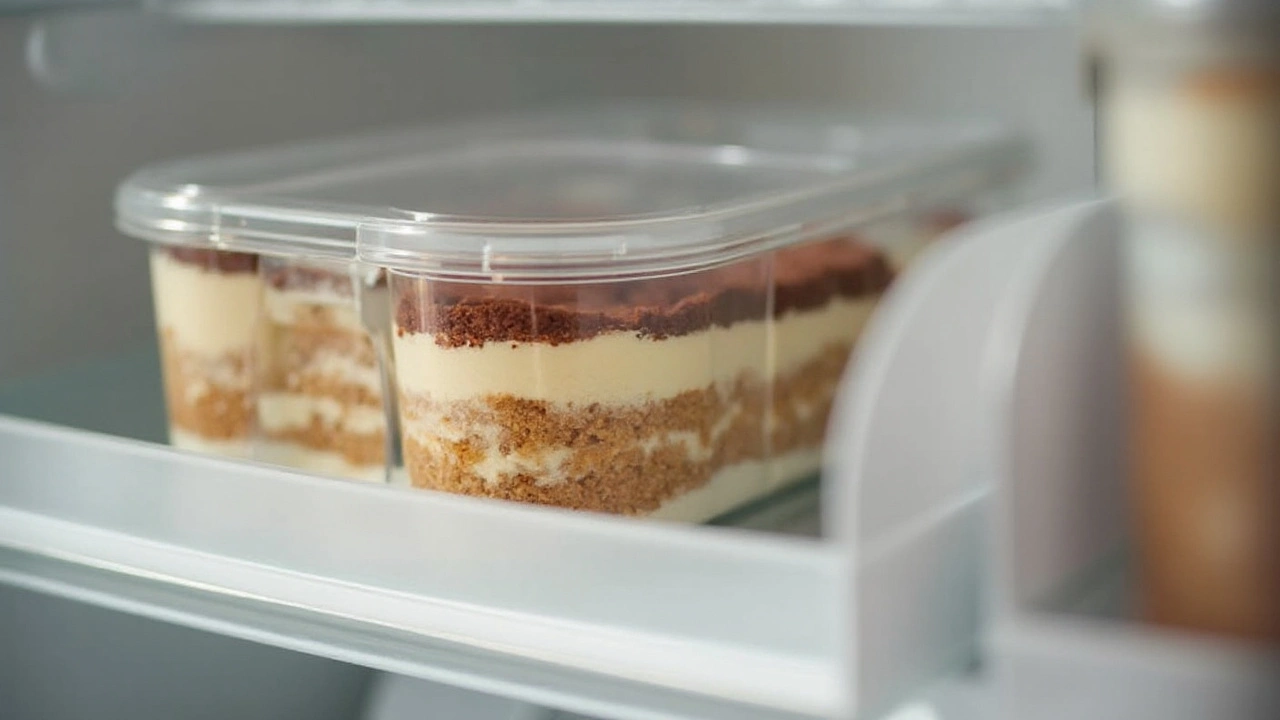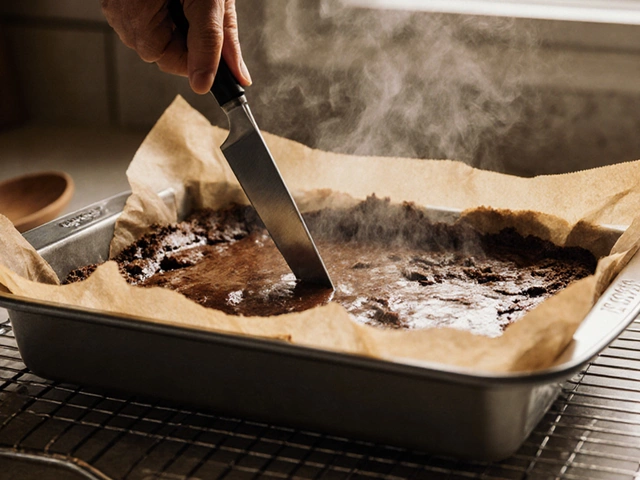
Few desserts can rival the indulgent layers of tiramisu, but once you've made or purchased this Italian treat, knowing how to store it properly can make all the difference in preserving its quality. From its creamy mascarpone cheese to coffee-soaked ladyfingers, each component requires delicate care to maintain the dessert's texture and flavor.
This article will guide you through the best methods for storing tiramisu, whether you're preparing it in advance or looking to save leftovers. With insights into choosing the right containers and understanding ideal refrigeration conditions, you'll be well-equipped to enjoy your tiramisu just as much a few days later as you did when it was fresh.
Let's uncover the secrets to keeping your tiramisu just as silky and satisfying as when it was first made.
- Understanding Tiramisu Ingredients
- Best Practices for Storing Tiramisu
- Containers for Freshness
- Refrigeration Techniques
- Shelf Life and Expiration
- Reviving Stored Tiramisu
Understanding Tiramisu Ingredients
Tiramisu is a symphony of flavors and textures, orchestrated by a blend of ingredients that are as comforting as they are luxurious. At its heart is mascarpone cheese, a creamy Italian staple that lends the dessert its signature richness. This cheese is not just any cream; it’s made from whole cream that has been thickened with the addition of acidic substances like lemon juice. The high-fat content of mascarpone is key to giving tiramisu its velvety texture, making it necessary to always use the freshest available to preserve the dessert’s taste.
The base of tiramisu is constructed with ladyfingers, or savoiardi, which are light, sweet sponge biscuits. These cater to the dessert's structure and absorb the harmonious mix of coffee and liqueur to perfection. The choice of coffee is crucial—traditionally, espresso is used for its strong, robust flavor that pairs well with the sweetness of the dessert. A mild coffee might not deliver the same richness to the palate. Equally important is the coffee’s companion, a splash of coffee liqueur or marsala wine, which adds depth and complexity.
Another vital component is the eggs, which are divided into yolks and whites and used separately to create the cream mixture. The yolks are beaten with sugar until pale and thick, then folded into the mascarpone. The whipped egg whites contribute to the dessert’s airy and decadent lightness. This step is what gives tiramisu much of its lift and subtle fluffiness. It's essential, however, to ensure that the eggs are fresh and handled properly to maintain the dessert’s integrity and safety.
"Using high-quality, fresh ingredients can transform an ordinary tiramisu into an extraordinary dessert," suggests Claudia Roden, an esteemed food writer.
A subtly sweet cocoa powder is gently dusted atop the final layer of cream. This not only enhances the presentation but also adds a slight chocolate bitterness that complements the sweetness of the concoction, balancing the palate. Some variations of tiramisu include grated chocolate instead of cocoa powder for a richer experience. Sugar is another component that cannot be ignored; it's used sparingly to enhance rather than dominate the natural flavors of the ingredients. Finally, while not part of every recipe, some chefs add whipped cream to the mascarpone mixture for an extra level of creaminess.
Preserving the integrity of these ingredients is paramount to maintaining the dessert's character. Understanding each ingredient's role allows for better handling during both preparation and storage. The delicate balance of textures and flavors in tiramisu is what makes it such a beloved dessert worldwide. By respecting each component, you ensure that this Italian classic remains as delicious as the day it was first created.
Best Practices for Storing Tiramisu
When it comes to storing tiramisu, the aim is to preserve its rich flavors and delicate textures just as they are intended to be savored. Tiramisu, with its creamy layers and coffee-infused base, can be both a dream to eat and a challenge to store correctly. First and foremost, you should always keep tiramisu in the refrigerator. This dessert relies heavily on ingredients like mascarpone cheese and eggs, which need to be refrigerated to prevent spoilage. It's crucial to wrap your tiramisu tightly. This prevents it from absorbing any unwanted odors from other foods and protects it from drying out in the fridge. Make use of plastic wrap or aluminum foil to cover the surface of the tiramisu thoroughly. If you've created a large batch, consider cutting it into portion-sized pieces before wrapping it up. This not only makes it easier to serve later but also ensures each piece stays fresh individually.
Choosing the right container can also make a big difference. While some people leave it in the dish it was prepared in, transferring it to an airtight container can offer better protection. Airtight containers help maintain the humidity level necessary for the dessert to retain its smooth texture. Moreover, it helps to keep the subtle notes of rum and espresso that make tiramisu so beloved. According to some chefs, placing a small sheet of parchment paper on the top layer's surface before sealing the container can further aid in maintaining moisture equilibrium. A noteworthy mention is the fact that tiramisu often tastes better the day after it is made, allowing the flavors to meld together delightfully. If you intend to store leftovers, be sure to mark the date on the wrapping or container as a reference to ensure it's consumed within a safe timeframe.
A frequent wonder among tiramisu enthusiasts is whether this luscious dessert can be frozen. The answer is yes, but with certain caveats to ensure its quality is preserved. Freeze tiramisu immediately if you plan to keep it for an extended period. Wrap it tightly in plastic wrap, making sure that no part is exposed. Then, add an extra layer of foil over the plastic for added protection against freezer burn. When ready to serve, it's important to thaw tiramisu slowly in the refrigerator, preferably overnight, to allow the structure to gradually regain its intended consistency. Throwing it directly from the freezer to room temperature may compromise its texture drastically.
"The magic of a perfect tiramisu comes not just from the ingredients but from understanding how each interacts with each other even after they've been combined," says Chef Anna Fiorina, a renowned pastry chef.
Remember, while refrigeration works wonders short-term, freezing should only be done if you absolutely must, as the change in texture can deter from the experience. By following these essential practices, storing your tiramisu can become an easy and effortless process.

Containers for Freshness
Choosing the right container is crucial for maintaining the delightful texture and taste of your tiramisu. The best containers are those that ensure that your dessert is protected from the drying effects of the refrigerator and also keep it from absorbing any foreign odors. A well-sealed environment helps lock in the moisture from both the mascarpone filling and the espresso-drenched ladyfingers, maximizing the dessert's shelf life. Glass or ceramic containers with snug lids are often preferred, as they provide a solid barrier while preventing flavor changes that occur with plastic. But if using plastic, ensure it is food-grade and BPA-free.
An ideal container size is also essential; it should allow the tiramisu to maintain its form while providing a little room for air circulation. This prevents the weight of a lid or cover from compressing the delicate layers. Consider investing in containers made specifically for desserts, which often have adjustable lids. These can expand or contract based on the volume of food, sustaining the original shape of your dessert with minimal air exposure. For those lacking proper storage solutions at home, makeshift setups using cling wrap may suffice, but these are not optimal for long-term storage as air tends to seep in over time.
"Proper storage plays a critical role in not only preserving a dessert's freshness but also its taste profile," says famed pastry chef Dominique Ansel. "The right container is as essential as the right refrigeration."
Visibility is also beneficial when it comes to storage. Transparent containers allow for a quick check on your dessert's condition without disrupting the environment inside. This proves advantageous for monitoring the shelf life of the tiramisu. Last but not least, label your container with the date it was stored. While this may seem trivial, keeping track of storage time is key to ensuring you consume the dessert at its freshest. Ideally, you want to enjoy your tiramisu within three to four days of preparation, maximizing the creaminess and fresh coffee notes.
In the art of storing tiramisu, using the perfect container is akin to framing a painting. It preserves its beauty and ensures it remains the centerpiece of your culinary collection until it's ready to be savored once again.
Refrigeration Techniques
When it comes to keeping your beloved tiramisu delectably fresh, understanding the role of refrigeration is key. This dessert, with its sumptuous layers, is marvelously sensitive to both time and temperature. Refrigerating tiramisu involves not just finding a spot in your fridge but setting it up for success so that every bite is as tantalizing as when it was first crafted. A proper approach means a difference between a soggy mess and a delightful, creamy indulgence.
First and foremost, it's essential to recognize that tiramisu is made up of perishable ingredients like mascarpone cheese and eggs, which inevitably require cold storage to remain safe for consumption. The ideal temperature for storing tiramisu is between 35°F (1.6°C) and 40°F (4.4°C), which is usually the default range for most refrigerators. Keeping it in an airtight container is not only crucial for maintaining the right humidity levels but also prevents it from absorbing any strong odors from other foods lingering nearby, a common pitfall in refrigeration.
It's important to place the tiramisu on the middle shelf of your refrigerator, where the temperature remains more consistent and unaffected by fluctuations caused by frequent door openings. This positioning helps keep each layer intact, preserving the dessert's original flavor and texture. Given its layered composition, some individuals also opt to cover the top with a plastic wrap before sealing it in a container for an added layer of protection. When you're ready to serve, remove it from the refrigerator and allow it to sit at room temperature for around 20 to 30 minutes, just enough for the flavors to come alive.
An insightful tip from renowned pastry chef Emily Luchetti advises, "Preparing and storing your tiramisu well in advance of serving time enables the flavors to meld together more naturally. Refrigeration enhances the taste, making every forkful a mastery of flavors."
If you've made tiramisu ahead of time for a large gathering, you might find yourself in a scenario needing storage beyond a few days. In this case, consider freezing the dessert. However, be aware that the freezing process can alter the texture slightly, mainly affecting the creaminess that tiramisu is celebrated for. If choosing to freeze, it's best to cut your dessert into individual servings before solidifying it. When ready to enjoy, simply transfer the serving to the fridge to thaw overnight. It's a handy approach if you don't mind a slightly denser version.
It's noteworthy to mention that despite the trials refrigeration poses, stored tiramisu emotionally remains more than 'just a dessert.' Similar to fine wines, this sweet delicacy evolves uniquely over the course of storage, often tasting better on the second day as the flavors harmoniously blend. With these refrigeration techniques in mind, you're guaranteed to enjoy a tiramisu experience that is genuinely extraordinary every time.

Shelf Life and Expiration
Understanding the shelf life of your beloved tiramisu is crucial to savoring it at its best. As a dessert that relies on fresh dairy components like mascarpone cheese and eggs, tiramisu has a shorter shelf life compared to more resilient desserts. Once assembled, tiramisu should ideally be consumed within 2 to 3 days to enjoy its optimal flavor and texture. The creamy layers can begin to separate, and the ladyfingers may become overly soggy if kept for too long.
Refrigeration plays a critical role in extending the life of tiramisu temporarily, keeping it safe but with certain limitations. Longer exposure to refrigeration can cause the espresso flavors to intensify, sometimes even muting the subtler layers that make this dessert so irresistible. According to culinary specialists, storing tiramisu beyond three days tends to alter its balance significantly, affecting both texture and taste. "The delicate harmony of tiramisu is best appreciated fresh," says Italian pastry chef Lucia Bertini.
"Refrigeration is key for food safety, but it's that fresh charm that wins hearts."
For those who wish to prolong the life of tiramisu, freezing might seem like a viable alternative. While freezing can indeed extend its shelf life to approximately two months, it demands an understanding that upon thawing, the texture is likely to shift. The tiramisu can lose some of its ethereal lightness, as moisture alteration upon freezing can affect its characteristic lushness. To freeze tiramisu properly, wrap it in several layers of plastic wrap to ward off freezer burn, ensuring minimal air exposure.
One must also pay attention to the expiration dates of individual ingredients when planning to make tiramisu ahead of time. Freshness starts at the grocery store—whether it’s selecting creamy mascarpone or the most reliable eggs. Ensure all ingredients will endure until the planned serving date, offering your guests the freshest experience. If you're not sure about using older ingredients, a good rule of thumb is: when in doubt, throw it out. Remember, this isn't just about taste; it's about safety.
Reviving Stored Tiramisu
Tiramisu is a beloved classic, yet after a few days in the fridge, its lively essence might mellow. Bringing a stored tiramisu back to its original glory requires a thoughtful approach. One can't simply let it linger and expect magic. The key lies in understanding the delicate balance of its ingredients and their reaction to storage.
First, check the appearance and aroma of the dish. If the tiramisu looks too dry on top or has absorbed excessive moisture from the refrigerator, a slight touch-up can do wonders. Consider using a gentle, plant-based syrup to lightly brush over the top layer of ladyfingers. This will rehydrate and refresh the initial coffee-kissed allure without altering its taste significantly. Remember, just a few swipes are enough to bring life back to the dessert without making it soggy.
Enhancing Flavors
When it comes to flavor, tiramisu's quite forgiving. If stored correctly, it often melds into deeper flavors over time. But sometimes, you might need a little boost. Adding a touch more cocoa powder on top can reignite its chocolaty notes. A slight sprinkle of espresso powder can sharpen its rich, coffee undertones, elevating it back to its intended balance. For those adventurous spirits, aromatically infused cocoa or experimental blends of coffee might offer an unexpected twist to a familiar classic. A fresh dusting can visually transform tiramisu, making it as irresistible as when first served.
Perfect Temperature
Temperature plays a crucial role in revival. Bringing the dessert to room temperature might amplify its rich flavors and augment its melt-in-the-mouth texture. To achieve this, let the tiramisu sit out for about 20-30 minutes. Observing the transformation as the layers soften slightly but still hold form is a rewarding experience. Remember not to leave it out too long, ensuring it retains its cool, creamy delight, especially in warm environments. The careful dance between cool firmness and gentle warmth can resurrect tiramisu to its authentic state, making every layer a delight.
"Reviving a stored tiramisu is like re-awakening the soul of the dessert," suggests culinary expert Giovanni Ragazzi. "Its layered composition offers enough room to play and rekindle its original vigor without overpowering its essence."
Serving Techniques
When it comes to serving, presentation matters almost as much as taste. For a refreshed experience, serve each slice with a petite spoonful of vanilla whipped cream or a small dollop of mascarpone on the side. Accompanying with a cup of freshly brewed espresso can contrast the creaminess with a jolt of bitterness, enhancing the full experience. The aesthetics create a multi-sensory indulgence, turning stored tiramisu into an occasion, not just a leftover moment. Sharing this revived delight with friends or loved ones can turn an ordinary day into a celebration of flavors.
| Factor | Impact on Tiramisu |
|---|---|
| Moisture | Enhances texture if refilled carefully |
| Temperature | Amplifies flavors when slightly warmed |
| Cocoa Powder | Restores chocolate zest |





